“If you can’t tell the difference between a vegan chocolate cake and a normal chocolate cake, just eat vegan ones in the future — they’re supposed to be healthier.” Words of wisdom from my mother.
A few hours earlier, my friend and I had planned to stuff our faces with juicy hamburgers after dining at Mianto (米愛多), a vegan restaurant on Xinsheng South Road (新生南路). I’ve had my share of vegan meals — all for the sake of food writing. But for someone raised on a steady diet of skewered pork and chicken curries, it was all bland and forgettable. Not to mention the pint-sized portions — hence the need for post-meal burger binges. The fact that Mianto was one of the two restaurants in Asia to make it on this year’s Vegans Are Cool outstanding restaurants list did make it more appealing. But the mere mention of chocolate cake made me concede.
Opened by South African expat Michel Cason and interior designer Antonio Chen (陳豐秀) over a year ago, the restaurant is a compact space with floor-to-ceiling glass windows looking out onto Lianyun Park (連雲公園). A bakery area occupies the entrance, where dark wood-paneled walls are covered with black-and-white portraits, evoking the vibe of a lower Manhattan cupcake joint. A raised platform where patrons must take off their shoes leads to the main dining area, which consists of communal tables, and a smaller seating area by the window for parties of two.
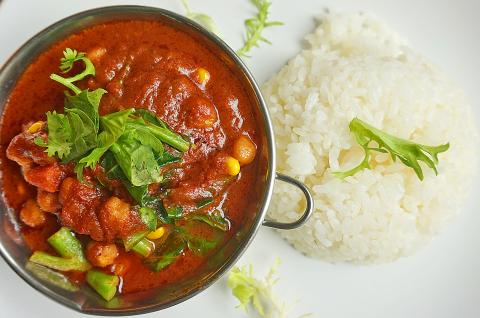
Photo: Dana Ter, Taipei Times
With burgers still on our minds, we place our orders — the highly recommended spaghetti al funghi (NT$250), chana ma soul la or chickpea curry (NT$250), a ciabatta plate (NT$150) and, of course, the vegan chocolate cake (NT$65).
I was pleasantly surprised to find that it wasn’t only the desserts that were delectable. The crunchy mix of shiitake mushrooms, spinach and shredded carrots in the spaghetti al funghi, pan-fried with onions, garlic and black pepper, was enough to convince me that it was possible for vegan food to be not just edible, but palatable as well. Smoky and slightly charred on the edges, the shiitake mushrooms — which are sourced from the misty mountains of Fuhsing District (復興) in Taoyuan — are the best component. I was grateful for the peppery kick combined with the natural sweetness of the carrots, both of which provided much flavor and texture to the spaghetti.
The chana ma soul la is a good choice for those who fear eating salads when dining with vegan friends. There’s not too much of a heavy curry taste in the dish. Rather, the assortment of Indian herbs soaked in a mildly spicy tomato-based curry tastes more like a sauce. The chickpeas — probably one of the blandest legumes imaginable — are enlivened by the minty, aromatic curry. Like the spaghetti al funghi, the ingredients in the chana ma soul la are crunchy and fragrant, but not overwhelmingly so. Though the dish is served with a scoop of white rice, I found myself scooping every last drop of the curry as if it were a bowl of rich, creamy soup.
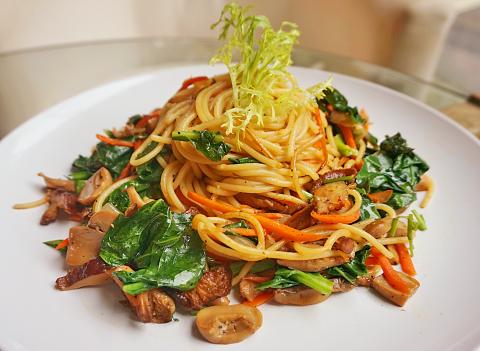
Photo: Dana Ter, Taipei Times
While technically an appetizer, we treated the ciabatta plate as a side dish to nibble on in between main courses. It pairs well with the olive oil, balsamic vinegar and olives, although I preferred to use it to mop up the last drops of curry. The homemade bread is served fresh from the oven with no added sugar or preservatives. The bread is soft and fluffy on the inside with a crust that crumbled delicately.
Finally, the vegan chocolate cake lived up to my expectations — for the most part. While the sponge layers were a little dry, the runny top layer of melted chocolate more than made up for it. There was only a sliver of cream, which I appreciated as I’m not a big fan of over-the-top indulgence.
Chocolate cake aside, it will still take a lot of convincing to convert me to veganism, but Mianto manages to make vegan dining enjoyable and tasty with subtle but memorable flavors.
After we combed up the last crumb, my friend looked up from his empty plate and asked, “Burgers?”
There was no need. We walked away with full, satisfied stomachs.
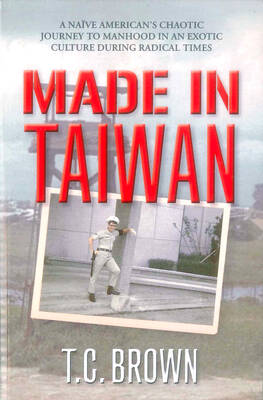
By 1971, heroin and opium use among US troops fighting in Vietnam had reached epidemic proportions, with 42 percent of American servicemen saying they’d tried opioids at least once and around 20 percent claiming some level of addiction, according to the US Department of Defense. Though heroin use by US troops has been little discussed in the context of Taiwan, these and other drugs — produced in part by rogue Chinese Nationalist Party (KMT) armies then in Thailand and Myanmar — also spread to US military bases on the island, where soldiers were often stoned or high. American military policeman
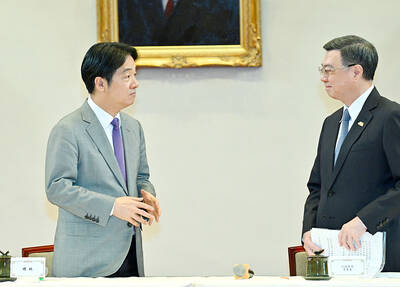
Under pressure, President William Lai (賴清德) has enacted his first cabinet reshuffle. Whether it will be enough to staunch the bleeding remains to be seen. Cabinet members in the Executive Yuan almost always end up as sacrificial lambs, especially those appointed early in a president’s term. When presidents are under pressure, the cabinet is reshuffled. This is not unique to any party or president; this is the custom. This is the case in many democracies, especially parliamentary ones. In Taiwan, constitutionally the president presides over the heads of the five branches of government, each of which is confusingly translated as “president”

An attempt to promote friendship between Japan and countries in Africa has transformed into a xenophobic row about migration after inaccurate media reports suggested the scheme would lead to a “flood of immigrants.” The controversy erupted after the Japan International Cooperation Agency, or JICA, said this month it had designated four Japanese cities as “Africa hometowns” for partner countries in Africa: Mozambique, Nigeria, Ghana and Tanzania. The program, announced at the end of an international conference on African development in Yokohama, will involve personnel exchanges and events to foster closer ties between the four regional Japanese cities — Imabari, Kisarazu, Sanjo and
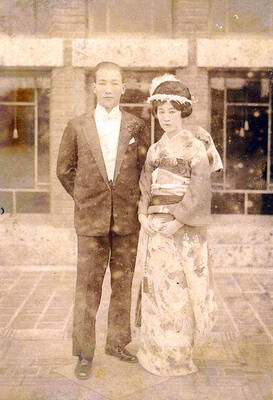
Sept. 1 to Sept. 7 In 1899, Kozaburo Hirai became the first documented Japanese to wed a Taiwanese under colonial rule. The soldier was partly motivated by the government’s policy of assimilating the Taiwanese population through intermarriage. While his friends and family disapproved and even mocked him, the marriage endured. By 1930, when his story appeared in Tales of Virtuous Deeds in Taiwan, Hirai had settled in his wife’s rural Changhua hometown, farming the land and integrating into local society. Similarly, Aiko Fujii, who married into the prominent Wufeng Lin Family (霧峰林家) in 1927, quickly learned Hoklo (commonly known as Taiwanese) and